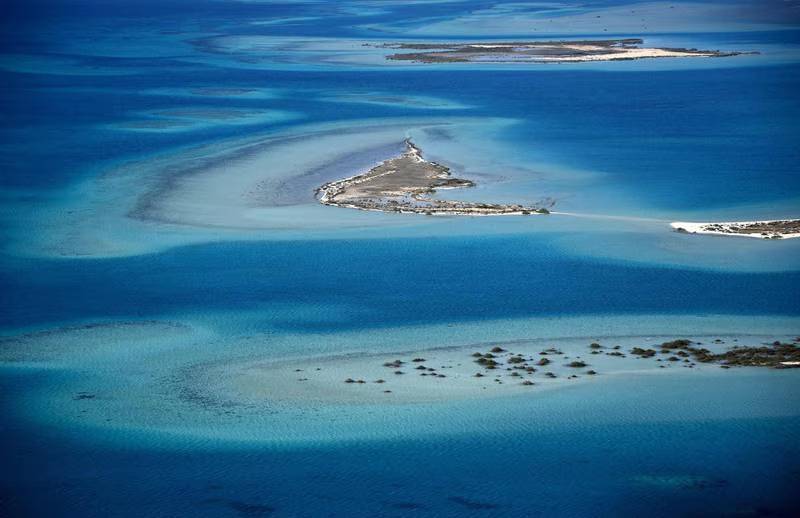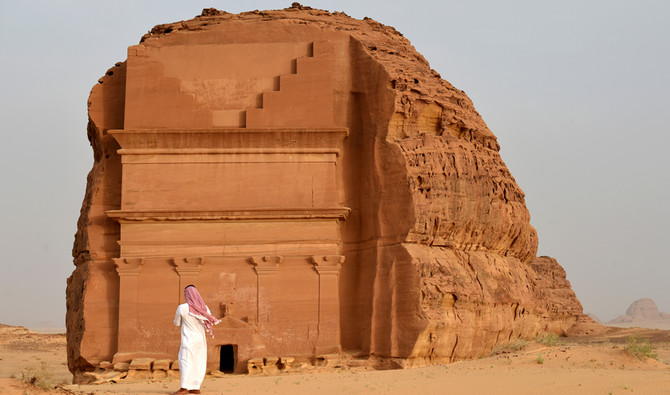
Infrastructure is being built on the Saudi Red Sea coast, which the Saudi government hopes to utilize for tourism. (Credit: AFP/File Photo)
Located just 20 kilometers from the Nabataean city of al-Ula in present-day Saudi Arabia, home to intricately carved stone tombs, lies a complex of opulent villas. A TikTok video of the destination has garnered an impressive 18.6 million views, courtesy of influential solo traveler @girlvsglobe. The viral sensation is part of a growing international interest in Saudi tourism.
Saudi Arabia has an ambitious plan to establish tourism as its second-largest revenue source, surpassing even oil, by the year 2030. The goal is for this burgeoning industry to contribute 10 percent to the nation’s GDP.
This objective is no mean feat, though the tourism sector has shown promising early results. In 2022, just four years after Saudi Arabia opened its borders to tourists, the industry generated a staggering $49.3 billion in revenue, according to official figures.
“Tourism is the new oil,” Fahd Hamiddadin, the head of the Saudi Tourism Authority, said at the Arabian Travel Market in Dubai in May.
The ambitious goal of attracting 100 million visitors by 2030 has already been nearly achieved, with the kingdom welcoming a remarkable 93.5 million visitors last year, more than double the figure from 2019.
However, it is important to consider the method of calculation used, which tends to put the figures into perspective. The authorities gauge visits rather than the number of individual tourists. In other words, if a traveler visits 10 different sites and spends a night at each one, they would be counted as 10 visits rather than one tourist.
 The al-Ula archaeological site in northern Saudi Arabia. (Credit: AFP/File photo)
The al-Ula archaeological site in northern Saudi Arabia. (Credit: AFP/File photo)
Extravagant projects
Saudi Arabia has spared no effort in the development of its tourism industry, utilizing it as both a showcase of its rapid modernization and a key component of its economic diversification strategy.
With an astounding budget of $1 trillion, the kingdom’s projects compete with one another in terms of extravagance. The Red Sea Project, spanning a vast 28,000 square kilometers, is the next venture set to be realized. This luxury eco-tourism destination along the Red Sea boasts 90 pristine islands of white sandy beaches and crystal-clear waters, promising uncharted coral reefs, volcanoes, dunes and canyons, as well as renowned hospitality brands such as Ritz Carlton, Marriott, and the forthcoming Six Senses spa hotel, slated to open soon.
Additionally, plans are in place for the launch of 13 more hotels by next year.
Among the ongoing construction projects is Trojena, envisioned as a desert ski resort, which has been designated to host the 2029 Asian Winter Games.
Sindalah, an international yacht haven island, is another facet of the futuristic planned megacity of Neom.
Neom, which is designed to run on renewable energy and artificial intelligence, commands a whopping $500 billion budget.
Al-Ula, serving as a symbol of the burgeoning tourist industry, currently stands as the only fully operational site. It has seen remarkable success, indicated by the extreme difficulty in securing seats on flights and accommodations during the peak season, which spans from October to April. “Today, the existing offerings are insufficient to accommodate the millions of tourists that flock here each year,” said a local informed source.
In May, the Royal Commission for al-Ula announced the upcoming launch of a new complex comprising 76 private villas with spa facilities, which is slated to welcome guests starting in 2027.
This situation highlights one of the paradoxes within Saudi Arabia’s tourism strategy: imposing exorbitant prices to deter mass tourism while simultaneously aiming to attract millions of visitors.
On the official al-Ula website, the initial accommodation offerings range from $1,384 to $4,525 per night during the peak season.
“They are specifically targeting individuals with high financial means and cultural appreciation,” said the source.
However, given this narrow focus on a small target audience, questions arise as to how the sector anticipates achieving its goal of accounting for 10 percent of GDP by 2030.
Undeniably, the rejection of mass tourism and the emphasis on ecotourism serve as compelling marketing arguments.
Tourism consultant Charles Phillips, who recently embarked on a two-month exploration of Saudi Arabia, has shared numerous photos on his social media platforms, dismantling the perception of a country solely comprised of sand.
Phillips said that it’s not just about Neom, al-Ula and the Red Sea, as Saudi Arabia boasts a multitude of captivating destinations, including forests and mountains in the south, the world’s largest oasis in the east, and vast deserts spanning the entire country.
His observations shed light on the province of Jizan, situated along the Yemeni border, where verdant, terraced mountains dominate the sandy plains, and coffee cultivation thrives.
Further north, in Asir, one can witness the picturesque stone and ceramic tower houses that epitomize southern Arabia, nestled within lush hills.
An exquisite example of this region’s architectural marvels is the al-Maqar Palace, adorned with its distinctive bulbous domes and intricately sculpted rosettes on the façade. The palace proudly stands at an elevation of 2,400 meters.
Saudi Arabia’s tourism strategy revolves around transforming two fundamental aspects of its tourism landscape. Firstly, the focus is on altering the composition of visitor motivations. The objective is to elevate leisure tourism’s share from 40 percent (2019) to 50 percent of the market by 2030 while reducing religious tourism from 38 percent to 32 percent, as outlined in a report by Lucidity Insights.
Secondly, the aim is to attract a larger proportion of international tourists. The country welcomed 16.5 million international visitors last year, with significant numbers originating from Kuwait, Bahrain, Pakistan, Egypt, Indonesia and India.
The target is to elevate this figure to 55 million by 2030, primarily by drawing in greater numbers of Chinese and Western tourists. However, Saudi Arabia is also heavily reliant on its vast domestic population, the largest in the Gulf region, to support the burgeoning infrastructure and contribute to the tourism sector’s growth.
According to an informed source in the local tourism industry, “If you want to attract middle-class Europeans who are seeking alternatives to destinations like Tunisia and Senegal, you can captivate them not only with the allure of al-Ula and exceptional diving experiences in the Red Sea, but also with the enigmatic side of Saudi Arabia — a destination that has historically been off-limits, but is now witnessing evolving social norms.”
While Saudi Arabia’s overall reputation may still be tarnished on social networks and in the Western media, primarily due to the brutal killing of journalist Jamal Khashoggi in 2018 and the ongoing Yemen war, this source suggests that the kingdom is increasingly being viewed through the lens of social openness, ambitious economic projects and sports achievements.
315,000 hotel rooms
Can Saudi Arabia’s infrastructure and services keep pace with the growth of its tourism industry?
The kingdom appears to be tackling this challenge directly by introducing e-visa facilitation for 49 countries, establishing Riyadh Air as a new airline to serve 100 international destinations, and announcing the opening of 315,000 hotel rooms.
However, there is a need for well-trained staff to provide international-standard service, which is a significant task considering Saudi Arabia has only been welcoming tourists for four years.
This constitutes a dilemma for the leaders of Vision 2030 as they aim to leverage the development of the tourism industry to provide job opportunities for Saudis.
The goal is to create one million jobs, primarily targeting the local workforce. However, according to the latest Tourism Ministry official figures from 2021, only 26 percent of tourism staff were Saudi nationals, indicating the need for significant progress.
According to Eleonora Cambedda, head of business development at a prominent Saudi agency, it is crucial for local staff to be trained in effectively catering to international tourists. This involves understanding the target audience, their cultural preferences and their specific needs. Language skills beyond English are also necessary to accommodate visitors from various countries. Cambedda's agency, for example, caters to a majority of French, Italian and German customers.
Young Saudis, who constitute two-thirds of the population and face high levels of unemployment (26.6 percent for people aged between 14-15 in 2021), are at the core of this initiative.
In March, Tourism Minister Ahmed al-Khatib announced plans to train 100,000 young people, including 10,400 who will receive training abroad.
Authorizing alcoholic beverages
The government will also need to address the regulations surrounding entertainment and the authorization of alcohol in tourist zones.
Regarding entertainment, significant progress has already been made, with Saudi Arabia now hosting large-scale music festivals and sporting events. This includes the Formula 1 Grand Prix, the LIV-PGA golf tournament, and the transfer of European football stars to Saudi clubs for staggering amounts of money. Ambitions to host a future FIFA World Cup further demonstrate the importance of sports, particularly football, in the kingdom’s tourism strategy.
However, the question of alcohol remains sensitive in a country that has been influenced by decades of Wahhabism. It is possible that the approach taken may resemble that of Qatar, where alcohol is available in luxury hotels in major cities. However, until specific royal decrees are published, it remains challenging to predict when and how these regulations will be implemented.
Under Mohammad bin Salman, Saudi Arabia has actively sought to shed its ultraconservative image and present itself as more progressive on matters of morality.
The official Visit Saudi website appears to reflect these changes, featuring a section dedicated to advice for women travelers. The first line emphasizes that wearing veils is not obligatory for women, and it offers recommendations for “girl’s trips” to various destinations.
Perhaps even more surprising is the inclusion of a statement on the website indicating that the kingdom is prepared to welcome LGBT tourists. The FAQs section asserts that personal details are not required or requested and that everyone is welcome to visit Saudi Arabia.
This represents a remarkable shift in a country where homosexuality has been historically punishable by death, even though the most recent execution, for this reason, dates back over 20 years.
This article was originally published in French in L’Orient-Le Jour. Translation by Sahar Ghoussoub.